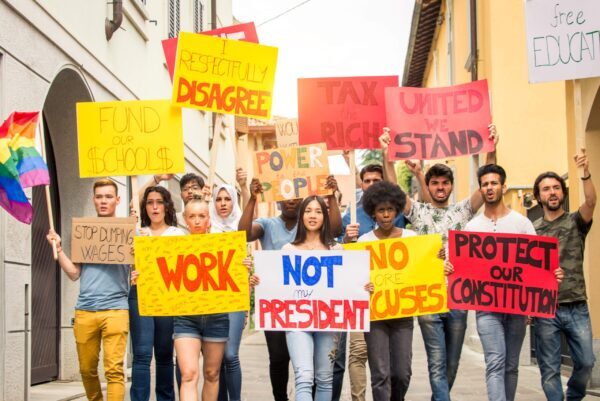Public unrest rarely begins with something radical. Usually, someone asks for a comment on the situation in the media or raises a question at a public meeting. Perhaps someone comes out to a building with a few posters. There are no loud slogans, threats, or demands.
Read also: Soft2Bet: Compliance and Regulation in iGaming
And then everything accelerates. The agenda begins to change. Another replaces one topic. Harsh comments appear, open letters are published, and social media erupt. The local community, which yesterday was loyal, begins to have doubts. And you, the public representative, are left in the center of this whirlwind.
What is going on? Why is the pressure mounting even though the situation is formally stable? Why do the protests seem spontaneous but act with frightening precision?
To understand this, you need to get to know the man who described it all long before it became fashionable. His name was Saul Alinsky. He provided step-by-step instructions on how to build public pressure on officials.
Who is Saul Alinsky?
Saul Alinsky was born in Chicago in 1909. In the 1920s, he studied sociology. In the 1930s, he began working with labor unions and poor neighborhoods, and by the 1940s, he was already training entire teams of organizers on how to build pressure on the authorities. His approach was not theoretical. He lived on the streets of the neighborhoods he worked in and knew how power worked, not from diagrams but from people’s views at meetings.
In 1971, he published Rules for Radicals, a handbook for those who want to change the system through organized action. In the book, Alinsky addresses a “new generation of radicals” and speaks to them simply: if you want results, act effectively.
This book became a tool for activists, trade unions, student movements, urban communities, and political campaigns. As paradoxical as it may sound, it can also be helpful for public workers. Understanding how a protest is built can help you manage the situation.
What’s Inside Rules for Radicals
The book is divided into two parts. The first explains the philosophy and principles, while the second describes tactics and tools. Alinsky shows how to act when resources are limited, how to unite disparate people, how to bring internal discontent to the surface, and how to create a sense that change is possible.
One of Alinsky’s central theses is that power is often not what you have, but what your opponent thinks you have.
Then come the rules. Some of them have become almost legendary:
- Choose a target. Freeze it. Personify it. Polarize it.
Activists do not attack the system as a whole. They find one person, turn them into a symbol of the problem, and focus all their energy on them.
- Laughter destroys faster than arguments.
Mockery, irony, and trolling—all of these things undermine authority. And most importantly, they are challenging to defend against.
- Your tactics should be fun for your people.
People return to interesting places. Successful campaigns are always creative, colorful, and easy to replicate.
- The pressure must be constant.
Protest works not because of its volume, but because of its rhythm. When something happens every day, your opponent loses their footing.
- Break the other side’s rules. And force them to live by yours.
Alinsky advises activists to use the authorities’ values as a tool of pressure.
All of this together creates not so much a movement as a script. And if you work on the public side, you need to be able to read this script from the first lines. Otherwise, you will find yourself in a role that has been chosen for you.
Why Does Pressure Work
Alinsky’s tactics work not because they are loud, but because they are accurate. They strike at the weak points of any public system: slowness, impersonality, disunity.
A public representative (official, deputy, head of a service) acts within the framework of procedures. Their words and actions are filtered through approvals, regulations, and reporting, creating a sense of distance. A protest organizer has a different logic. Their task is to destroy trust in the public without entering into confrontation.
How this looks in practice:
- First, simple, clear criticism appears. For example, “the city is spending money on parking lots instead of playgrounds.”
- Then the criticism is personalized: “A specific official is responsible for this, and he is doing nothing.”
- Next, the community gets involved: letters, videos, pickets, memes.
- All this is accompanied by new demands, accusations, and “insider information.”
If the authorities react aggressively, this is used as proof of guilt. If they remain silent, it is used as proof of indifference. It’s a fork where any behavior is interpreted as weakness.
Understanding that the activists’ goal is not to solve the problem is essential. Sometimes the goal is to stir things up as much as possible. Sometimes, it mobilizes supporters and prepares the ground for future campaigns.
How Public Officials Should Act
Now to the main point. If you are a representative of the authorities, how should you work in the context of such a campaign? Below are six tactical principles that have been tested in real-life situations.
1. Maintain a clear and straightforward information position
Activists rarely argue with facts. They say with interpretations. Therefore, your task is to prepare short, clear messages in advance. And don’t complicate things.
- Don’t promise anything that depends on other agencies or levels of government.
- Don’t just say “what we are doing,” but also ‘why’ and “in what order.”
- Use visual aids: diagrams, infographics, timelines.
Respond to each new wave of questions with “What’s new here?” and repeat your leading position.
2. Repeat. Again and again.
Activists deliberately create a sense of information overload. You need to counter this with stability.
- Repeat key points, even if you think you’ve already said them.
- Don’t change your rhetoric with the tide. It comes across as confusion.
- Don’t be afraid to “sound repetitive.” Repetition is a sign of confidence.
3. Use micro-initiatives
One of the protest’s goals is to show no progress. Your job is to prove the opposite.
- Launch small, symbolically significant actions. Even simple things like cleaning up the area or installing a trash bin can send a signal.
- Publicly acknowledge progress. Use social media, meetings, and photo reports.
4. Expand responsibility
If you have been chosen as a “personalized target,” you must leave that position immediately.
- Move the conversation to an institutional level. Speak on behalf of the team, not yourself.
- Bring in other speakers: experts, colleagues, representatives of authorities.
- Explain that the decision is being made as part of a general procedure.
5. Respond ironically but respectfully
Alinsky considered ridicule to be the most potent weapon. It destroys symbolic status. Therefore, you need to defuse tension with lightheartedness.
- Use self-irony: “Yes, the flagpole fell down at the entrance. We’ve already figured out how to turn it into an art object.”
- Show the behind-the-scenes work. People are likelier to trust those they see “in real life” rather than at meetings.

6. Keep a log of interactions
Activists create pressure through numbers: dozens of appeals, calls, and statements. It’s important not to get lost.
- Record every request, even if it repeats a previous one.
- Respond formally even if you don’t have an answer yet.
- Start a public communication log. Let everyone see that the dialogue is systematic.
What’s the Bottom Line?
Alinsky’s method works because it exploits human reactions. It does not require money or power. It requires attention and discipline. And it is dangerous because most structures do not have a ready answer to it. But that answer can be built through confidence, consistency, and participation.
In a world where mobilization has become the norm, the role of a public servant is to be a stable, understandable point in a field of uncertainty. And this is precisely what Alinsky could not take into account. Because he wrote for the weak. And you are a representative of the strong side. This means that you have access to a whole new level of play.

